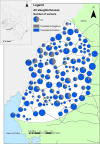Prevalence and risk factors for exposure to Toxoplasma gondii in slaughterhouse workers in western Kenya
- PMID: 34511066
- PMCID: PMC8436527
- DOI: 10.1186/s12879-021-06658-8
Prevalence and risk factors for exposure to Toxoplasma gondii in slaughterhouse workers in western Kenya
Abstract
Background: Toxoplasma gondii is a zoonotic protozoan parasite infecting warm-blooded animals. Infection in people can occur through ingestion of oocysts passed in the faeces of the definitive hosts; ingestion of bradyzoites in the tissue of infected intermediate hosts; or exposure to tachyzoites in raw milk and eggs. Slaughterhouse workers are considered a high-risk group for T. gondii exposure because of their contact with raw meat, although a positive relationship between handling raw meat and T. gondii seropositivity has not been demonstrated in all studies. This study aimed to determine the seroprevalence of antibodies to T. gondii in slaughterhouse workers in Kenya and identify risk factors associated with seropositivity.
Methods: A survey of slaughterhouse workers was conducted in 142 slaughter facilities in the study area. Information regarding demographics, contact with livestock, meat consumption, and practices in the slaughterhouse was collected using structured questionnaires. Commercial ELISAs were used to detect IgM and IgG antibodies against T. gondii and a multi-level logistic regression model was used to identify potential risk factors for seropositivity in slaughterhouse workers.
Results: The apparent prevalence of antibodies to T. gondii was 84.0% (95% Confidence Interval (CI) 81.2-86.5%) for IgG and 2.2% (95% CI 1.3-3.5%) for IgM antibodies. All IgM positive individuals were IgG positive. Risk factors for exposure to T. gondii were: increasing age (Odds Ratio (OR) 1.03; 95% CI 1.01-1.05); owning poultry (OR 2.00; 95% CI 1.11-3.62); and consuming animal blood (OR 1.92; 95% CI 1.21-3.03).
Conclusions: The seroprevalence of antibodies to T. gondii was very high in this population and considerably higher than published values in the general population. Risk factors included age, owning poultry and drinking animal blood which were consistent with previous reports but none were specifically associated with working in the slaughterhouse. In this instance slaughterhouse workers may represent a useful sentinel for the general population where the level of exposure is also likely to be high and may signify an unidentified public health risk to vulnerable groups such as pregnant women. A detailed understanding of the epidemiology of infection is required, which should include an assessment of incidence, mortality, and burden since T. gondii infection is likely to have life-long sequelae.
Keywords: Abattoir; Kenya; Occupational health; Slaughterhouse; Toxoplasma; Zoonoses.
© 2021. The Author(s).
Conflict of interest statement
The authors declare no competing interests..
Figures
Similar articles
-
Seroprevalence and associated risk factors of Toxoplasma gondii infection among slaughterhouse workers in Yangon Region, Myanmar: A cross-sectional study.PLoS One. 2023 Apr 13;18(4):e0284352. doi: 10.1371/journal.pone.0284352. eCollection 2023. PLoS One. 2023. PMID: 37053192 Free PMC article.
-
Seroprevalence of anti-Toxoplasma gondii IgG antibody and risk factors among abattoir workers in Uyo, Southern Nigeria.Niger J Clin Pract. 2018 Dec;21(12):1662-1669. doi: 10.4103/njcp.njcp_44_18. Niger J Clin Pract. 2018. PMID: 30560833
-
Toxoplasma gondii infection in workers occupationally exposed to raw meat.Occup Med (Lond). 2011 Jun;61(4):265-9. doi: 10.1093/occmed/kqr032. Epub 2011 Apr 22. Occup Med (Lond). 2011. PMID: 21515666
-
Seroprevalence of Toxoplasma gondii in the Iranian pregnant women: A systematic review and meta-analysis.Acta Trop. 2016 Jun;158:160-169. doi: 10.1016/j.actatropica.2016.03.003. Epub 2016 Mar 4. Acta Trop. 2016. PMID: 26952970 Review.
-
A Review on the Prevalence of Toxoplasma gondii in Humans and Animals Reported in Malaysia from 2008-2018.Int J Environ Res Public Health. 2020 Jul 3;17(13):4809. doi: 10.3390/ijerph17134809. Int J Environ Res Public Health. 2020. PMID: 32635389 Free PMC article. Review.
Cited by
-
Antimicrobial Resistance in Slaughterhouses, Kenya.Emerg Infect Dis. 2023 Oct;29(10):2155-2158. doi: 10.3201/eid2910.230017. Emerg Infect Dis. 2023. PMID: 37735786 Free PMC article.
-
Epidemiology of Toxoplasmosis among the Pakistani Population: A Systematic Review and Meta-Analysis.Pathogens. 2022 Jun 10;11(6):675. doi: 10.3390/pathogens11060675. Pathogens. 2022. PMID: 35745528 Free PMC article. Review.
-
The global seroprevalence of Toxoplasma gondii infection in workers occupationally exposed to animals (1972-2023): a systematic review and meta-analysis.Vet Q. 2024 Dec;44(1):1-18. doi: 10.1080/01652176.2024.2396577. Epub 2024 Aug 29. Vet Q. 2024. PMID: 39205625 Free PMC article.
-
Prevalence of preconception TORCH infections and its influential factors: evidence from over 2 million women with fertility desire in southern China.BMC Womens Health. 2023 Aug 10;23(1):425. doi: 10.1186/s12905-023-02560-4. BMC Womens Health. 2023. PMID: 37563634 Free PMC article.
-
The antimicrobial resistance landscape of slaughterhouses in western Kenya: A microbiological case study.One Health. 2024 Sep 19;19:100899. doi: 10.1016/j.onehlt.2024.100899. eCollection 2024 Dec. One Health. 2024. PMID: 39381065 Free PMC article.
References
MeSH terms
Substances
Grants and funding
LinkOut - more resources
Full Text Sources
Medical


